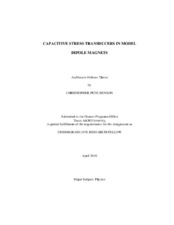| dc.description.abstract | Capacitive stress transducers are used to measure mechanical stresses in the windings of superconducting dipole magnets. These transducers consist of a bonded laminate composed of alternating foils of stainless steel and a high-strength polymer known as polyimide. The thin, flat design of the transducers is ideal for measuring the integrated Lorentz stresses within the windings when current is flowing in the coil to generate a magnetic field.
The process of fabricating and calibrating these custom gauges has proven to be a non-trivial problem. Previously, many variables have been left unchecked during the fabrication and calibration phases thus leading to non-repeatable transducers.
My goal is to improve upon current methods of transducer fabrication to yield more consistent responses and robust packages. To accomplish this, new techniques and fixtures have been developed to control factors, such as layer alignment, thickness variability and calibration consistency. New fixtures that have been developed are a polyimide cutting fixture, a new transducer alignment and epoxy curing fixture, a torque fixture, and a re-machined testing fixture. These new fixtures, coupled with new techniques, will increase the repeatability and reliability of the transducers.
Incorporating these fixtures has lead to a 75% decrease in thickness variations across the length of the transducers, 62% reduction in total epoxy thickness and a 70% decrease in number of pressure cycles required for calibration curve convergence. While these improvements produce impressive results, additional transducers are being constructed and calibrated to verify these findings. The improved fabrication and calibration methods and fixtures, results and conclusions will be discussed. | en |


